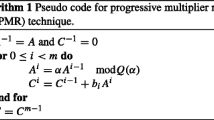Abstract
The complexity of adding twon-bit numbers on a two-dimensional systolic array is investigated. We consider different constraints on the systolic array, including:
-
whether or not the input and output ports lie on the periphery of the array,
-
constraints placed on the arrival and departure times of inputs and outputs
.
For all combinations of the above constraints, we obtain optimal tradeoffs among the resources of area, pipeline delay, and worst-case time. It turns out that there is a subtle interplay among the constraints and some of our results seem counterintuitive. For instance, we show that allowing more-significant bits to arrive earlier than less-significant bits can speed up addition by a factor of logn. We also show that multiplexing can often result in a smaller array. On the other hand, we show that some known results, such as Chazelle and Monier's bounds for arrays that have input/output ports on the perimeter, also hold in less constrained models.
Similar content being viewed by others
References
M. J. Atallah and S. R. Kosaraju, Graph Problems on a Mesh Connected Processor Array,Proc. Fourteenth ACM Symposium on the Theory of Computing, pp. 345–353, 1982.
A. Atrubin, A One-Dimensional Real Time Iterative Multiplier,IEEE Transactions on Computers, Vol. 3, pp. 394–399, 1965.
G. M. Baudet, On the Area Required by VLSI Circuits, inProc. CMU Conference on VLSI Systems and Computations, Computer Science Press, Rockville, MD, pp. 100–107, 1981.
G. Bilardi and F. P. Preparata, Area-Time Lower Bound Techniques with Applications to Sorting, Tech. Report, University of Illinois, Urbana-Champaign, 1985.
B. M. Chazelle and L. Monier, A Model of Computation for VLSI with Related Complexity Results,Proc. Thirteenth ACM Symposium on the Theory of Computing, pp. 318–325, 1981.
B. M. Chazelle and L. Monier, Optimality in VLSI,Proc. First International Conference on VLSI, pp. 269–278, 1981.
L. Guibas, H. T. Kung, and C. Thompson, Direct VLSI Implementation of Combinatorial Algorithms,Proc. Caltech Conference on VLSI, California Institute of Technology, pp. 309–325, 1979.
R. B. Johnson, The Complexity of a VLSI Adder,Information Processing Letters, Vol. 11, No. 2, pp. 92–93, 1980.
S. R. Kosaraju, Speed of Recognition of Context-Free Languages by Array Automata,SIAM Journal of Computing, Vol. 4, pp. 331–340, 1975.
H. T. Kung and C. Leiserson, Algorithms for VLSI Processor Arrays,Proc. Symposium on Sparse Matrix Computations, Knoxville, TN, 1981.
R. J. Lipton and R. Sedgewick, Lower Bounds for VLSI,Proc. Thirteenth ACM Symposium on the Theory of Computing, pp. 300–307, 1981.
C. D. Thompson, Area-Time Complexity for VLSI,Proc. Eleventh ACM Symposium on the Theory of Computing, pp. 81–88, 1980.
J. D. Ullman,Computational Aspects of VLSI, Computer Science Press, Rockville, MD, 1984.
Author information
Authors and Affiliations
Additional information
Communicated by F. Thomson Leighton.
The research of S. Rao Kosaraju was supported by NSF Grant No. MCS 8506361.
Rights and permissions
About this article
Cite this article
Aggarwal, A., Carter, J.L. & Kosaraju, S.R. Optimal tradeoffs for addition on systolic arrays. Algorithmica 6, 49–71 (1991). https://doi.org/10.1007/BF01759034
Received:
Revised:
Issue Date:
DOI: https://doi.org/10.1007/BF01759034




